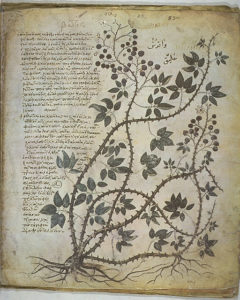Dioscorides as Art and Research
Submitted by our 2018 ARC Fellow Team:
Andrew Griebeler (History of Art) and Maria Mavroudi (History)
 The oldest surviving comprehensive Greek botanical work was written by Dioscorides around the first century AD. Other technical authors from around the same time were Galen on medicine, Ptolemy on the mathematical sciences, and Artemidorus on dream interpretation. All four emphasize that their writings incorporate both received tradition and experience acquired through practical application. All four were extremely successful in communicating technical knowledge, as their wide medieval reception in Greek, Latin, and Arabic proves. All four viewed the act of writing as art and lived in a universe where the same word, techne, designated both a craft (like what they were exercising with their technical knowledge) and a fine art. While all four favored a relatively non-embellished writing style primarily serving clarity, they did strive to write well. Modern scholars have commented on Ptolemy’s rich vocabulary, including words that are unique in Greek prose. Dioscorides and Artemidorus beg the reader’s indulgence for their preference for simplicity. Galen had a more complex (even prolix) writing style but explicitly admired Dioscorides’ succinctness and lucidity.
The oldest surviving comprehensive Greek botanical work was written by Dioscorides around the first century AD. Other technical authors from around the same time were Galen on medicine, Ptolemy on the mathematical sciences, and Artemidorus on dream interpretation. All four emphasize that their writings incorporate both received tradition and experience acquired through practical application. All four were extremely successful in communicating technical knowledge, as their wide medieval reception in Greek, Latin, and Arabic proves. All four viewed the act of writing as art and lived in a universe where the same word, techne, designated both a craft (like what they were exercising with their technical knowledge) and a fine art. While all four favored a relatively non-embellished writing style primarily serving clarity, they did strive to write well. Modern scholars have commented on Ptolemy’s rich vocabulary, including words that are unique in Greek prose. Dioscorides and Artemidorus beg the reader’s indulgence for their preference for simplicity. Galen had a more complex (even prolix) writing style but explicitly admired Dioscorides’ succinctness and lucidity.
As these works moved from one language to another, and even as they were read within the same language over the centuries, their adequate understanding required knowledge of their linguistic register as well as the techne they expounded. An obvious aid facilitating comprehension was scientific illustration.
Some of Dioscorides’ predecessors had opted to illustrate their works but Dioscorides apparently did not. He instead described plants clearly in words. Still, pictures of plants were eventually added to some later versions of his work. In this way, two different ways of approaching the study of plants came together. Like the art of writing, painting can be a form of research. Painters and writers could both aspire to communicate a plant’s morphology with detail and clarity. Like writers, painters carefully select what parts of a plant to show and how to do so.
An example of the breadth of knowledge such pictures could convey is provided by the illustration of a wild blackberry from the renowned sixth-century manuscript known as the Vienna Dioscorides: it shows various plant parts at different stages of development, including opened and unopened flowers, flowers loosing their petals, as well as mature (purple) and immature (red) fruit. We see both young and old growth, including the dead, broken end of one branch. Below it, another branch takes root—suggestive of how the plant grows into dense thickets. Leaves appear flattened and tilted toward the viewer, indicating leaf margin, shape, and venation. Yet many leaves also curl to show their undersides. The illustration suggests an intention to communicate as clearly as possible—similarly to Dioscorides’ approach to writing—a variety of plant parts at different stages of growth.
Later transformations of the Greek botanical tradition are also recorded on the page of the wild blackberry illustration: at the beginning of the fifteenth century, the sixth-century text was transliterated into a different type of Greek script (the minuscule) which at that time was easier to read. Several decades later (after the fall of Constantinople to the Ottomans in 1453) the manuscript received extensive annotations in Ottoman Turkish, Arabic, Hebrew, and Persian. Next to the illustration of the blackberry, a transliteration of its Greek name was recorded in Arabic and Hebrew letters along with its translation into Arabic. These annotations reflect an abiding interest in the text and in establishing the identity of a plant between languages.
Andrew Griebeler is a PhD Candidate at the University of California, Berkeley’s Department of Art History. He studies medieval and Byzantine art with Diliana Angelova and Beate Fricke. Andrew graduated with a B.A. in art history and biology at the University of Puget Sound in Tacoma, Washington. Andrew’s research interests include manuscripts, spolia, and medieval science and image theory.
Maria Mavroudi is Professor of Byzantine History and Classics at the University of California, Berkeley. Her research focuses on the contacts between Byzantium and the Arabs, the medieval reception of ancient Greek learning in the Byzantine and the Islamic worlds, and the history of Byzantine science. Link to Faculty Profile here.
Note:Over the course of the spring semester, each 2018 ARC Fellows team will submit a short blog post about their project and findings. We hope you will enjoy these short readings! The Fellows Program advances interdisciplinary research in the arts at UC Berkeley by supporting self-nominated pairs of graduate students and faculty members as they pursue semester-long collaborative projects of their own design. To learn more about the program, click here.
